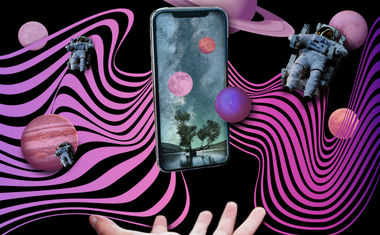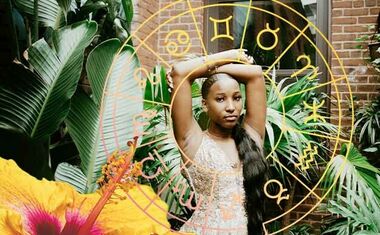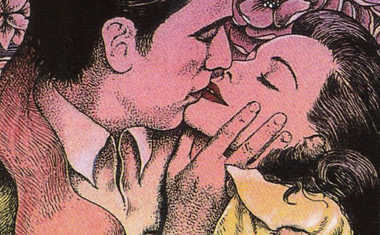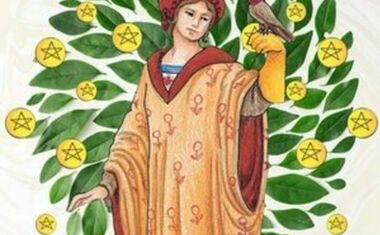
Iconology of the Wheel Cards
From the Iconology Section of the Robert O'Neill Library
Introduction
The six surviving Wheel of Fortune cards (#10) from the 15th/16th century are shown in Figure 1. The same basic theme appears on all of them.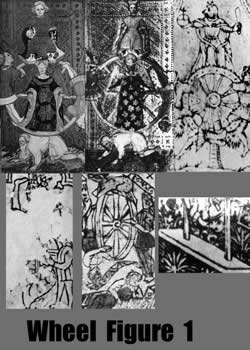 There is a figure ascending, atop, descending, and beneath the wheel. In two cases, the figure of blind fortune appears at the center. On some cards, the figures have captions in Latin: "I shall reign", "I reign", "I have reigned", "I don't reign".
There is a figure ascending, atop, descending, and beneath the wheel. In two cases, the figure of blind fortune appears at the center. On some cards, the figures have captions in Latin: "I shall reign", "I reign", "I have reigned", "I don't reign".
The foolishness of depending on Fortune is symbolized by the figures growing ears and tails. In two case the figure on top is shown as an animal. The basic idea seems to be that relying on fortune reduces one to the status of an animal. Humans with reason (and faith) do not need to do that. Some contemporary images (Thomson 2000, p. 17) show thefigures as asses. Notice that the first two cards in Figure 1 (upper left) treat the top figure rather more kindly. These two cards come from hand-painted decks that were commissioned by ruling families. Clearly the artist had the good sense not to depict his patron as an ass!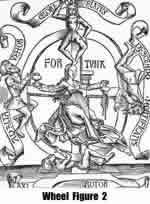
The basic image of the Wheel of Fortune was common and the card-player would have been familiar with it. Figure 2 shows a typical 16th century example. Notice that the central figure, representing blind fortune, is without eyes. In two of the early Tarot cards (Figure 1) she is represented as blindfolded. Another example of a contemporary image can be found in Willeford (1969, Plate 33).
The symbol dates back at least to the late 12th century (Figure 3). Another image from ~1230 can be seen in Panofsky (1960, fig. 59).
The religious tradition
 Although the image of the Wheel of Fortune is basically a secular allegory, its moral overtones were taken up and used in the religious tradition as well. One interesting version from the late 12th century (Figure 4) shows the wheel displaying the virtues and various other components of true religion. Figure 4 is a mneumonic device to assist one in memorizing the various elements. This is one of the clearest examples of a Tarot symbol connected with the Art of Memory (O'Neill 1986). A similar devise with the 4 cardinal virtues and 4 evangelists can be found in Katzenellenbogen (1939, fig. 69). In another variation from a Psalter (Davidson 1989, fig. 19), the wheel becomes the various ages of a man and illustrates the inevitability of death and judgment (Figure 5).
Although the image of the Wheel of Fortune is basically a secular allegory, its moral overtones were taken up and used in the religious tradition as well. One interesting version from the late 12th century (Figure 4) shows the wheel displaying the virtues and various other components of true religion. Figure 4 is a mneumonic device to assist one in memorizing the various elements. This is one of the clearest examples of a Tarot symbol connected with the Art of Memory (O'Neill 1986). A similar devise with the 4 cardinal virtues and 4 evangelists can be found in Katzenellenbogen (1939, fig. 69). In another variation from a Psalter (Davidson 1989, fig. 19), the wheel becomes the various ages of a man and illustrates the inevitability of death and judgment (Figure 5).
The triumphal tradition
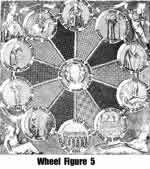 Fortune is only mentioned once in Petrarch's poem, in the Triumph of Death: "I take my course, ere Fortune strike at you, turning your sweetness into bitterness." However, Fortune appears as a distinct triumphal figure in the artistic tradition (Panofsky 1939, Plate 46). The images usually show a blindfolded Fortuna, but do not contain the typical wheel symbol.
Fortune is only mentioned once in Petrarch's poem, in the Triumph of Death: "I take my course, ere Fortune strike at you, turning your sweetness into bitterness." However, Fortune appears as a distinct triumphal figure in the artistic tradition (Panofsky 1939, Plate 46). The images usually show a blindfolded Fortuna, but do not contain the typical wheel symbol.
The dance of death tradition
The Wheel of Fortune doesn't appear in the illustrations of the Dance of Death. However, there are a few images of the Wheel of Fortune that show the estates of man represented by figures around the wheel (Figure 6, from 1554).
The apocalyptic tradition
The Wheel of Fortune also does not ordinarily appear in the apocryphal tradition. The only example that I have located (Link 1995, p. 113) shows a wheel in the center of an image of the last judgment. However, this is not the full image with figures ascending and descending on the wheel.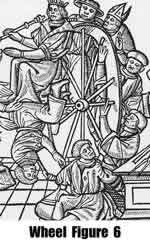
Iconological analysis
There is another representation of "Fortuna" that was common during the Middle Ages, and appears to have become dominant in the late Renaissance and later periods. This symbol shows "Fortuna" as a blindflooded woman, standing balanced on an unstable sphere. This image is often with a sail depicting the "winds of fortune". This is the image that appears on the so-called Tarocchi de Mantegna print of Fortune (Wind 1958, fig. 53). This representation of the Roman goddess of Fortune may have replaced the Wheel image because it better conveyed the later Humanist Renaissance desire to incorporate classical imagery. An example of the "Fortuna" symbol can be seen at:
monika.univ.gda.pl/~literat/grafika/fortuna.htm
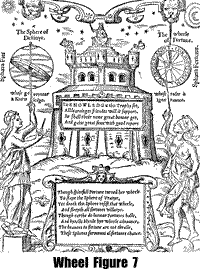 It is likely that the card-player would have seen the symbol of the Wheel of Fortune or the goddess "Fortuna" associated and contrasted with related symbols. Figure 7 contrasts fortune with astrology. Fortune is blindfolded and standing on an unstable sphere. Astrology is represented as knowledge standing on a stable cube. The implication is that knowledge of the natural world through astrology permits one to escape fickle fortune. Notice that Figure 7 also contains images of a Tower, Stars, Moon, Sun, and the Empress as wisdom atop the tower of knowledge. We will see a similar gathering of Tarot symbols in many contemporary images which indicates that the card-player would have seen the Tarot trumps as related to each other, rather than as a random miscellany.
It is likely that the card-player would have seen the symbol of the Wheel of Fortune or the goddess "Fortuna" associated and contrasted with related symbols. Figure 7 contrasts fortune with astrology. Fortune is blindfolded and standing on an unstable sphere. Astrology is represented as knowledge standing on a stable cube. The implication is that knowledge of the natural world through astrology permits one to escape fickle fortune. Notice that Figure 7 also contains images of a Tower, Stars, Moon, Sun, and the Empress as wisdom atop the tower of knowledge. We will see a similar gathering of Tarot symbols in many contemporary images which indicates that the card-player would have seen the Tarot trumps as related to each other, rather than as a random miscellany.
Figure 8 from 1510 shows an image similar in intent to Figure 7. Here blind fortune is contrasted with Sapientia, i.e., wisdom. Notice, once again, that the frame around Wisdom's mirror contains Stars, Moon, and Sun. The reference to astrology is clear and once again we see the juxtaposition of different Tarot symbols that seem unrelated only to the modern viewer.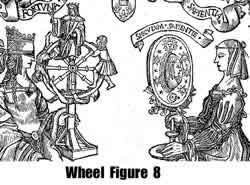
The association of symbols is even more complex in Figure 9 from a 1526 book of divination. Here the central (1) Wheel is the celestial sphere with the (2) Pope in the reigning position. Fighting for control of the wheel are an (3) Angel and a (4) Devil. The image also contains a (5) Tower with a (6) Sun on its side and an astrologer that resembles those of some of the early (7) Star cards. The book contains no reference to Tarot, but the association of the Wheel with fortune and divination is clear. It is hard to ignore the presence of 7 Tarot symbols in an illustration for a book of divination!
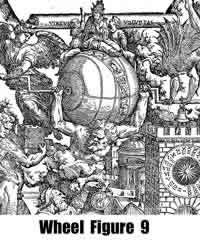 Figure 10 is a horoscope from 1515. Starting at about the 7 o'clock position, we find an artisan resembling some of the early Bagatto card, the Lovers at about 2 o'clock, the Death, Pope, Emperor, Wheel, and a man in stockade perhaps representing the Hangedman. In an inner circle we find the zodiacal signs of the Stars. Within the circle of stars we find the planets with Moon and Sun and Mars possibly referencing the Chariot. At the hub of the circle is the World as it appears in the early Tarot cards. So here we see as many as a dozen of the Tarot images represented on the great circle of time and associated with astrology as a divinatory tool.
Figure 10 is a horoscope from 1515. Starting at about the 7 o'clock position, we find an artisan resembling some of the early Bagatto card, the Lovers at about 2 o'clock, the Death, Pope, Emperor, Wheel, and a man in stockade perhaps representing the Hangedman. In an inner circle we find the zodiacal signs of the Stars. Within the circle of stars we find the planets with Moon and Sun and Mars possibly referencing the Chariot. At the hub of the circle is the World as it appears in the early Tarot cards. So here we see as many as a dozen of the Tarot images represented on the great circle of time and associated with astrology as a divinatory tool.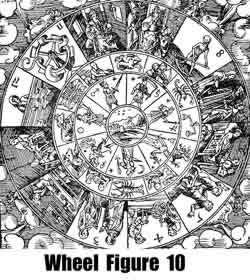
Figures 7 to 10 provide empirical evidence for the contemporary association of the Tarot symbols with astrology and divination. The evidence for an association with white magic is more tenuous. However, we do know that the 15th century saw the representation of divinatory devices into circles (Wade 1998). One example was the use of a circle and spinner to locate fortunes in a book. We also know that this transformation was largely influenced by the Ars Brevis of Ramon Llull (Bonner 1993). The art of Llull was seen by contemporaries as magical. The complex story of Llull potential influence on the Tarot will have to be delayed until a later article.
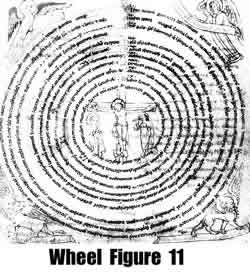 The circumstantial evidence for the association between the Wheel of Fortune image and magic involves the Ars Notoria (Camille 1998). More detailed information on this form of ritual magic can be found in the separate article on late medieval magic. For present purposes, it will suffice to point out that, as a memory device, the complex magical incantations involved in the Ars Notoria were displayed as a "rota", a Latin word for wheel. Figure 11 shows a 13th century image of a rota. The first thing to notice about Figure 11 is the crucifixion scene in the center and symbols for the four evangelists in the corners. Although the Ars Notoria was condemned by the Church, the inventor of this form of ritual magic developed it as an orthodox Christian ritual and symbolic system.
The circumstantial evidence for the association between the Wheel of Fortune image and magic involves the Ars Notoria (Camille 1998). More detailed information on this form of ritual magic can be found in the separate article on late medieval magic. For present purposes, it will suffice to point out that, as a memory device, the complex magical incantations involved in the Ars Notoria were displayed as a "rota", a Latin word for wheel. Figure 11 shows a 13th century image of a rota. The first thing to notice about Figure 11 is the crucifixion scene in the center and symbols for the four evangelists in the corners. Although the Ars Notoria was condemned by the Church, the inventor of this form of ritual magic developed it as an orthodox Christian ritual and symbolic system.
The second thing to notice about Figure 11 is almost too obvious to deserve mention. It can be argued that the 15th century card-player was ignorant of the magical connotations of the Wheel of Fortune symbol, but A. E. Waite certainly wasn't! A comparison of the "rota" in Figure 11 with the card drawn by Pamela Colman Smith indicates why the Waite-Smith deck added the symbols of the evangelists and the letters "rota" to the card. Clearly these are hidden references to the ritual magic of the Ars Notoria.
Interpretation
The symbolism of the Wheel of Fortune was common in the 15th/16th centuries and there is little doubt that the card-player would have recognized the imagery. The card-player's reaction to the symbol would have been multi-layered. The fickleness of fate was an important concept in the medieval culture (Gurevich 1988). Unpredictable and uncontrollable famine, plague, and war often overwhelmed the feeble efforts of man. No matter how high one rose, one still fell victim to the turning of the wheel and the old man is represented as crushed beneath. Perhaps the card-player would have associated the wheel with the torture and guilt associated with the experience of a lifetime.
Nevertheless, hope springs eternal and the foolishness of depending on blind fortune was contrasted with knowledge and wisdom gained from seeing the future in astrology and other forms of divination. Contemporary symbolism seems to bring out the hope of overcoming the ignorance of faith with the wisdom of "science" in the form of astrology.
The connection between the Tarot symbol of the Wheel of Fortune and divination is indirect. There is no hint of divination in the Tarot. But contemporary imagery associated with divination (Figures 7 and 8) seems to draw out a connection with the Wheel of Fortune symbol. Thus we find evidence of 7 Tarot symbols in Figure 9 and as many as 12 in Figure 10. This cannot be taken as proof that the card-player recognized the Tarot as a divinatory tool. But clearly somebody saw an association of the Tarot symbols with other forms of divination.
The association of the Wheel of Fortune symbol and the ritual magic of the Ars Notoria would probably not be apparent to the ordinary card-player. But the fact remains that some segments of the 15th and 16th century Italian culture were well aware of the Ars Notoria and the intellectual debates about its orthodox. So it would not be at all surprising if contemporary scholars saw the same connection with the Wheel of Fortune that Waite saw.
